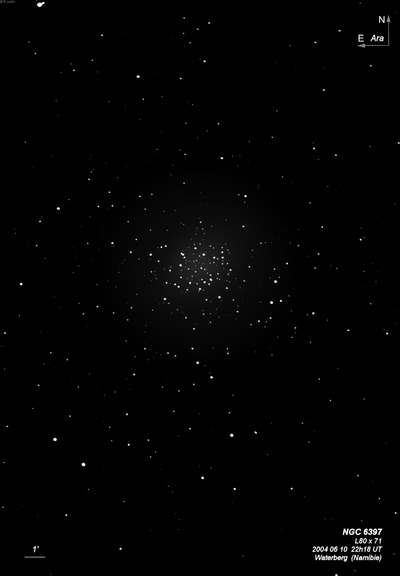
10x30 (8/8/04 - Haleakala Crater): picked up while sweeping in IS binoculars close to the SSW horizon from Haleakala. Once the position was pinpointed, this mag 5.8 globular was just visible naked-eye less than 1 degree NNE of mag 5.3 Pi Arae.
Nicolas-Louis de Lacaille discovered NGC 6397 = Lac III-11 = D 366 = h3692 in 1751-1752 with a 1/2" telescope at 8x, during his expedition to the Cape of Good Hope. He simply noted "faint star in nebulosity." James Dunlop independently found this globular on 28 Jun 1826 with his 9-inch reflector and described "a pretty large nebula, extended nearly in the parallel of the equator, brightest and broadest in the middle; a group of very small stars in the middle give it the appearance of a nucleus, but they are not connected with the nebula, but are similar to other small stars in this place which are arranged in groups. The nebula is resolvable into stars." Dunlop made 4 observations and his position was 5' east of center.
On John Herschel's first observation (8 Jul 1834), he recorded "globular cluster; fine; large; bright; round; gradually brighter to the middle; not very compressed; 5' diameter, but stragglers extend a great way. In the middle is a more compact group of much smaller stars. The stars at circumference are larger than in the middle; at N.f. border is a double star."
200/250mm - 8" (7/13/91 - Southern Baja): very bright, very large, 10' diameter, irregularly round. At least 50 stars mag 10-12 are resolved at 63x. Bright intense core 3' diameter with dozens of stars superimposed and at the edges of the core. The cluster contains a large halo with many faint and brighter stars superimposed over a mottled background. Beautiful globular although observed at only 13° elevation from Baja. This is the nearest globular and first in ranking by brightest stars.
400/500mm - 20" (7/8/02 - Magellan Observatory, Australia): I also had a fantastic view in the 20" f/5 at 212x - the stars seemed to radiate out from the core in spiral curves and completely filled the 23' field!
Notes by Steve Gottlieb